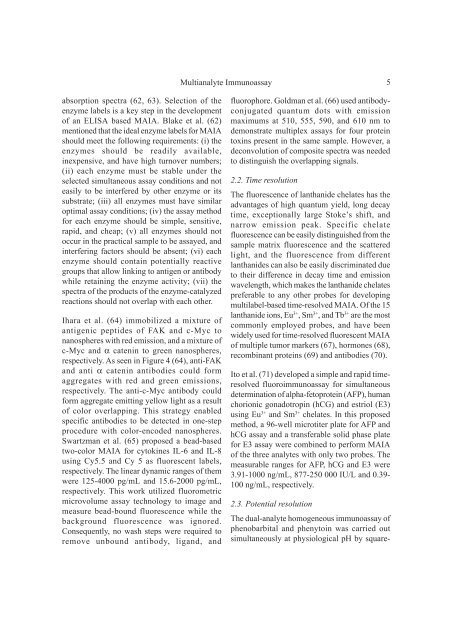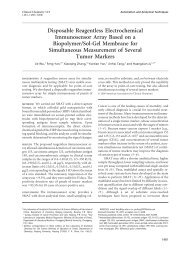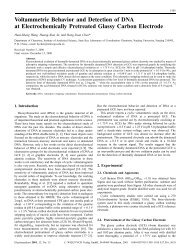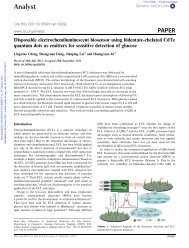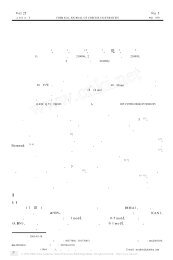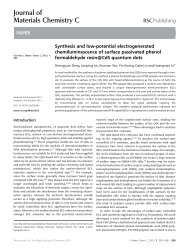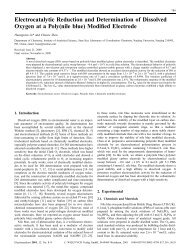Full paper
Full paper
Full paper
Create successful ePaper yourself
Turn your PDF publications into a flip-book with our unique Google optimized e-Paper software.
Multianalyte Immunoassay 5<br />
absorption spectra (62, 63). Selection of the<br />
enzyme labels is a key step in the development<br />
of an ELISA based MAIA. Blake et al. (62)<br />
mentioned that the ideal enzyme labels for MAIA<br />
should meet the following requirements: (i) the<br />
enzymes should be readily available,<br />
inexpensive, and have high turnover numbers;<br />
(ii) each enzyme must be stable under the<br />
selected simultaneous assay conditions and not<br />
easily to be interfered by other enzyme or its<br />
substrate; (iii) all enzymes must have similar<br />
optimal assay conditions; (iv) the assay method<br />
for each enzyme should be simple, sensitive,<br />
rapid, and cheap; (v) all enzymes should not<br />
occur in the practical sample to be assayed, and<br />
interfering factors should be absent; (vi) each<br />
enzyme should contain potentially reactive<br />
groups that allow linking to antigen or antibody<br />
while retaining the enzyme activity; (vii) the<br />
spectra of the products of the enzyme-catalyzed<br />
reactions should not overlap with each other.<br />
Ihara et al. (64) immobilized a mixture of<br />
antigenic peptides of FAK and c-Myc to<br />
nanospheres with red emission, and a mixture of<br />
c-Myc and α catenin to green nanospheres,<br />
respectively. As seen in Figure 4 (64), anti-FAK<br />
and anti α catenin antibodies could form<br />
aggregates with red and green emissions,<br />
respectively. The anti-c-Myc antibody could<br />
form aggregate emitting yellow light as a result<br />
of color overlapping. This strategy enabled<br />
specific antibodies to be detected in one-step<br />
procedure with color-encoded nanospheres.<br />
Swartzman et al. (65) proposed a bead-based<br />
two-color MAIA for cytokines IL-6 and IL-8<br />
using Cy5.5 and Cy 5 as fluorescent labels,<br />
respectively. The linear dynamic ranges of them<br />
were 125-4000 pg/mL and 15.6-2000 pg/mL,<br />
respectively. This work utilized fluorometric<br />
microvolume assay technology to image and<br />
measure bead-bound fluorescence while the<br />
background fluorescence was ignored.<br />
Consequently, no wash steps were required to<br />
remove unbound antibody, ligand, and<br />
fluorophore. Goldman et al. (66) used antibodyconjugated<br />
quantum dots with emission<br />
maximums at 510, 555, 590, and 610 nm to<br />
demonstrate multiplex assays for four protein<br />
toxins present in the same sample. However, a<br />
deconvolution of composite spectra was needed<br />
to distinguish the overlapping signals.<br />
2.2. Time resolution<br />
The fluorescence of lanthanide chelates has the<br />
advantages of high quantum yield, long decay<br />
time, exceptionally large Stoke’s shift, and<br />
narrow emission peak. Specific chelate<br />
fluorescence can be easily distinguished from the<br />
sample matrix fluorescence and the scattered<br />
light, and the fluorescence from different<br />
lanthanides can also be easily discriminated due<br />
to their difference in decay time and emission<br />
wavelength, which makes the lanthanide chelates<br />
preferable to any other probes for developing<br />
multilabel-based time-resolved MAIA. Of the 15<br />
lanthanide ions, Eu 3+ , Sm 3+ , and Tb 3+ are the most<br />
commonly employed probes, and have been<br />
widely used for time-resolved fluorescent MAIA<br />
of multiple tumor markers (67), hormones (68),<br />
recombinant proteins (69) and antibodies (70).<br />
Ito et al. (71) developed a simple and rapid timeresolved<br />
fluoroimmunoassay for simultaneous<br />
determination of alpha-fetoprotein (AFP), human<br />
chorionic gonadotropin (hCG) and estriol (E3)<br />
using Eu 3+ and Sm 3+ chelates. In this proposed<br />
method, a 96-well microtiter plate for AFP and<br />
hCG assay and a transferable solid phase plate<br />
for E3 assay were combined to perform MAIA<br />
of the three analytes with only two probes. The<br />
measurable ranges for AFP, hCG and E3 were<br />
3.91-1000 ng/mL, 877-250 000 IU/L and 0.39-<br />
100 ng/mL, respectively.<br />
2.3. Potential resolution<br />
The dual-analyte homogeneous immunoassay of<br />
phenobarbital and phenytoin was carried out<br />
simultaneously at physiological pH by square-


